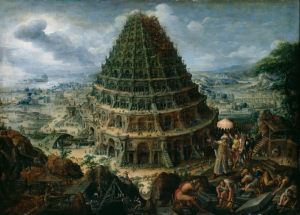In Steven Millhauser’s “The Tower,” the audience is introduced to a tower that represents that of the Biblical tower of Babel. While we are all aware that the people of Babylon failed to build a tower reaching up to heaven, Millhauser uses the horizontal and vertical world as a tool to present different problems that are relatable to the human experience. One main problem Millhauser focused on was  the dire changes in our environment that are starting to mold into normalcy. In addition to this, Millhauser presents the problem (or lack thereof,) of communication, with the exaggeration of stories to sound more appealing than what happened. This relates to how in the human experience we often exaggerate events that we witnessed so that our version of the stories we tell, and our life, appear more interesting. This can be paralleled to the Biblical tower of Babel, where God mixed up the language of the people of Babylon in order to prevent the tower from being built.
the dire changes in our environment that are starting to mold into normalcy. In addition to this, Millhauser presents the problem (or lack thereof,) of communication, with the exaggeration of stories to sound more appealing than what happened. This relates to how in the human experience we often exaggerate events that we witnessed so that our version of the stories we tell, and our life, appear more interesting. This can be paralleled to the Biblical tower of Babel, where God mixed up the language of the people of Babylon in order to prevent the tower from being built.
Was it possible that the great Tower didn’t actually exist? After all, no one had ever seen the entire structure, which kept vanishing from sight no matter where you stood. Except for a handful of visible bricks, the whole thing was little more than a collection of rumors, longings, dreams, and travelers’ tales. It was less than a memory. The Tower was a prodigious absence, a soaring void, a pit dug upward into the air. It was as if each part of the visible Tower had begun to dissolve under the vast pressure of the invisible parts, operating in every direction.
Kayley,
As someone who is not religiously affiliated, I find your post to be quite interesting. Do you think that the Fantastic is incorporated into bible stories?